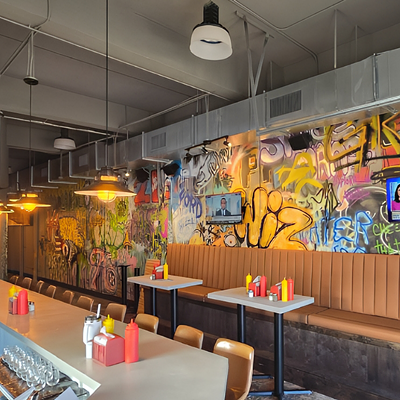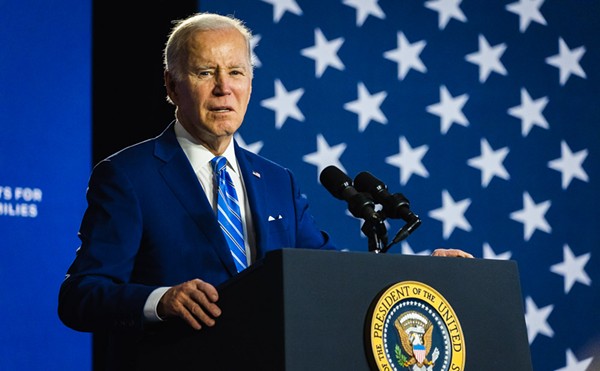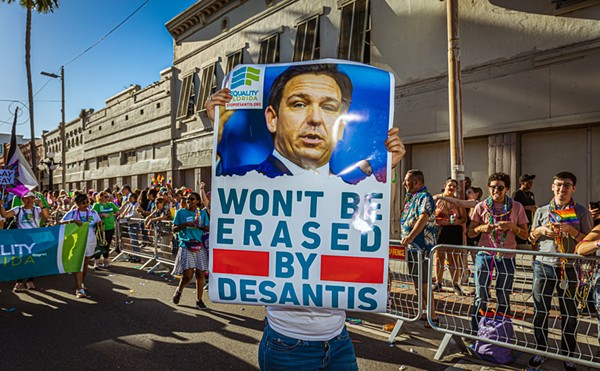Rocky Bridges never became the baseball player his father wanted him to be. But now, at age 37, he seems poised to hit a different sort of home run with the bases loaded. Rocky's phenomenal journey has taken him from his Tarpon Springs hillside home to an early friendship with an internationally acclaimed artist, an art degree from New York's Cooper Union and a museum retrospective at age 31. And this summer, the national exhibition that may be his defining moment.
His journey is marked as much by curve balls and detours as by triumphs. What all this means for his future is unclear.
At the end of a perfect Saturday May afternoon in Tarpon Springs, Rocky and his wife Kathleen are preparing for their annual art “Garage Sale” — one of those word-of-mouth, last-minute affairs mixing family, friends, colleagues and collectors. This is his childhood home, a small frame house where guests usually enter through the back door, directly into the kitchen. The rooms are charmingly illogical, the front of the house on a much lower level than the back. Standing by the retro kitchen table in the partially remodeled kitchen, the artist points to drawings he made as a child, still preserved on the raw wallboard.
Kathleen has been working in the kitchen for hours; her burritos and enchiladas are wrapped and ready to warm on the grill. Guests sprawl around the deck, beer in one hand, guacamole and chips in the other.
Conversation focuses on the Florida fella they’re all rooting for. In four days, Rocky will load a rented truck with 36 pieces of his mixed-media art and drive straight through to Washington, D.C.’s, prestigious Corcoran Gallery of Art.
At 37, the hometown boy who looks 10 years younger has a shot at the big time. His solo exhibition will open there on June 25.
Founded in 1869, the Corcoran, just a block from the White House, is the capital’s first museum of art. It’s also one of the oldest in the country.
If you’re wondering how an authentic Florida Cracker gets an exhibition at such a venerable institution, the short answer is that Rocky, an established Bay area artist, won a National Foundation for Advancement in the Arts (NFAA) visual arts fellowship in 1999. Of 183 visual arts applicants that year, he was one of three winners. The exhibition is his grand prize.
The Miami-based NFAA was established in 1981 with broad national support from corporations, foundations and philanthropic institutions, plus a board of distinguished individuals.
In 1989, NFAA initiated Fellowships in the Visual Arts (FIVA), aimed at identifying and boosting emerging or mid-career artists. In 1997, David Levy, Corcoran Director and longtime NFAA board member, linked the two institutions by adding curatorial assistance and the promise of national exposure for the fellows. This fellowship was tailor-made for artists like Rocky, who juggled artmaking with supporting his young family. He has taught art at two schools: Lakeland’s Lois Cowles Harrison Center for the Visual and Performing Arts, a formidable daily commute; and St. Petersburg College, Seminole campus. He will soon add the college’s Tarpon Springs campus to his load.
Sweetening the win was a three-year contract detailing yearly renewable stipends for living expenses and art materials, plus four months of free studio space in Miami and a South Beach apartment. The proposed Corcoran exhibition was set for June 2003, after which, according to what NFAA told their fellows, the museum would close for several years for renovations.
Corcoran curator Eric Denker, who selected Rocky’s exhibition pieces from collectors in three Bay area counties, was chief juror when the artist was chosen. In a telephone interview, Denker explained that the sole criterion for selecting artists was the visual impact of their work. No names or other identifying information was attached to the art.
He described Rocky’s art as compelling. “His work and the other two, just jumped out at us.”
The fellowship did take a toll on Rocky’s family. Rocky and Kathleen, now married for six years, have been together since becoming sweethearts during their junior year at Tarpon Springs High School. A major supporter of Rocky for 20 years, the unflappable Kathleen remembers how difficult it was, especially for their two girls. “I knew that he had to do this when he applied,” she says. “He asked what I thought. It didn’t matter how I felt. For me it was just another step.” Indeed, the proposed residency, stretched over three summers, would have added up to an entire year away from home.
Once in Miami, Rocky was hit by what he saw as a plastic world. “I didn’t know what was real or not,” he says. “Such a perfect society of plastic people made me question what people are about.” He was also confronted by a complete sense of freedom, an unanticipated spin-off of a fellowship with few restrictions. On the downside, this meant working in isolation with little or no social or professional interaction. Guidelines addressed only the security of the studio space, a situation he describes as, “here are the keys. Please lock up when you leave.”
In a lighter vein, the sensuous South Beach color and culture infiltrated Rocky’s mixed-media assemblage and painting. Tourists laud Miami’s art deco and glamorous nightlife, but he extols the Miami garbage dump, scene of his hunt for prized castaway trash. “Such tremendous salvage yards — so many airplane bodies ...” His decades-old romance with decay and recyclable industrial residue led to a looseness and more fluid expressionistic style. Huge assertive numerals suggested coded language. His earlier tendencies toward classically composed, balanced compositions gave way to a freeing impulse, as if his meticulously placed media had a mind of its own.
Rocky says that during the first residency period, in 2000, he and the other two fellows were told that the program would be discontinued after 2002. They were asked if they’d be willing to finish their second-year residencies under new guidelines. This meant staying for six months instead of four during the second year and not returning at all during the third summer. In effect, they would lose two months of their promised studio time.
According to Rocky, all three declined the offer. In the summer of 2001, they returned to Miami for another four months.
But something was amiss. At the end of the summer, while Rocky was making plans to store his studio materials, the bad news came. Fully expecting to return the next year to prepare for his Corcoran exhibition, he was stunned when he heard through the South Beach Arts Center that NFAA would not be renewing his studio lease. Rocky remembers thinking how strange it was that such vital information did not initially come through the foundation.
Another fellow, painter Eric Hesse, learned of losing his studio for the following year when a maintenance man showed up with a tape measure and acknowledged that the artist would not be coming back. In a telephone interview, Hesse described his constant dilemma of being grateful for his fellowship opportunity yet critical of what he views as NFAA’s neglect and lack of professionalism.
In July 2001, feeling extremely vulnerable and unable to get answers because of constant NFAA personnel turnover, the artist e-mailed Bill Banchs, president of the foundation. In this letter, Hesse, who makes his living solely through his painting, cites numerous failings, including the foundation’s repeated failure to respond when he addressed serious issues. These include broken promises, receiving his stipend late (sometimes by several months), and his burglarized apartment”.
Acknowledging NFAA’s severe financial losses and unexpected skyrocketing rental prices in Miami during the 1990s, Dr. Banchs says that administrators were sorry about not informing the fellows in a timely manner about impending changes. He reports that the board will consider the future of the fellowship program during their next annual meeting. Hesse hopes that this publicity will sharpen the program when and if it’s reinstated, that communication will be improved, and that contractual agreements will be more clearly understood.
Chattanooga-based sculptor and longtime NFAA Board member John Henry is surprised at the artists’ accusations. While admitting that their endowment had been in financial difficulty for the last three years — a problem exacerbated by 9/11 — he says he was assured that fellows were properly notified about changes. Suggesting that internal arguments within the board focused on NFAA’s changing mission and the fellowship’s future, Henry is nevertheless proud that their visual arts program assisted artists in ways that no other organization has. Their focus has now shifted to a core program revolving around a national talent search for high school students in the arts.
Rocky attempted unsuccessfully to get firm answers to his own questions from Lisanne Martin, the liaison between the artists and NFAA. Though she eventually told him that he’d definitely be working at home the third year, he assumed that the fellows would receive funds equivalent to the components of the fellowship that had been eliminated. The loss meant four months of an all-expense-paid apartment and studio space.
Rocky now faced preparing for the show of a lifetime without a studio. The situation was aggravated by frequent turnover of NFAA personnel, and even his request for substitute studio space in Tarpon Springs came to nothing. Gina Kuczwanski, head of the FIVA program, tried to be helpful, telling him to get prices for studios. When he phoned again about a week and a half later, she too was gone, with no explanations given. No substitute subsidy was ever paid.
The situation soon worsened. In late 2001, Rocky got a letter from the foundation. With no advance warning, and still fully expecting his Corcoran exhibition to be held in June 2003, he was informed that his show would open a full year earlier, on June 25, 2002. He was not only stunned, but in a real bind.
He had devoted his first two summers at the Miami studio to constructing work for two other major exhibitions. The first, scheduled for New York, unfortunately fell through at the last minute. The second was a solo show at Lakeland's Polk Museum. All of this work was sold to collectors.
Believing all along that the Corcoran exhibition was slated for 2003, Rocky had counted on the final residency year to create a totally new body of work that had never been seen. He had already made commitments to teach during the winter and spring, so making new art would be nearly impossible. The abrupt rescheduling also caused logistical headaches for Hesse, who had another exhibition planned just before the museum show. He too planned to use his third year to experiment with a new body of work.
Rising to the Challenge
Starting YoungThe Learning CurveAfter high school, Rocky and Kathleen enrolled at the Savannah School of Art. Although they were there only one year, what Rocky learned at the school led to one of the most significant and memorable periods in his life. One professor suggested he investigate the work of three 20th century superstar artists: Robert Rauschenberg, Joseph Beuys and Cy Twombly.
Rocky had never heard of Cy Twombly.
That didn't stop him from writing to the Virginia-born expatriot abstractionist, perhaps most famous for a style known as automatic scribbling. A close friend and colleague of Rauschenberg, Twombly was then living half of each year in Rome.
With his customary hometown boy innocence, intense focus and sheer gutsiness, Rocky told Twombly, 'I've never heard of you before and I'm unable to find many images of your work." He also mentioned that he was coming to Greece to visit his sister.
His interest piqued, Twombly sent Rocky five books on his art. And the precious all-important invitation: 'Please feel free to stop by."
Kathleen remembers Twombly's exact words: 'With a name like Rocky Bridges, how could I refuse?" (Rocky's father named him after major league baseball player Rocky Bridges. The artist, a schoolboy ball player, always dreamed of meeting his namesake).
Rocky took up the offer, stopped by, and was invited to stay with the famed artist and his family for a month.
Did he show his work to Twombly? 'Yes, and I tried to trade with him but he declined."
'He was really encouraging though. He advised me to always follow my heart and my passion."
Twombly drove him around Rome, pointing out reconstructed ruins like the Coliseum. He also paid for Rocky to tour Turkey, the Aegean Coast and the Greek islands with Alessandro, Twombly's son. Contrasting with the rebuilt ruins, he found greater personal and aesthetic affinity in the monumentalized decay around him. The young artist also admired the significance of the disorder, a theme echoing in his own found-object structures.
Back home, Rocky continued his education with an associate's degree from St. Petersburg College and one semester in the Dominican Republic. Finally coming to terms with his lack of formal education, he applied to and was accepted at New York City's Cooper Union. This was an easy decision. All students were on scholarship.
Joining Rocky in New York, Kathleen secured a job at 1-800-Flowers. She was promoted to head designer and her work was featured on popular morning television shows.
Again Rocky found champions, a necessity in an environment where he felt that what he calls his 'raw Southern" character could have been an extreme disadvantage both in school and in the city. During this period, a prized professor, former assistant to famed Yale color theorist Josef Albers, introduced him to the notion of color as a language. He was also excited by street trash and decaying material from the Hudson River Pier, all precursors to the Miami garbage dump. Anything and everything became art media.
His education complete, Rocky and Kathleen returned to Tarpon Springs to care for his sick mother. Rocky was offered a teaching job at Polk Museum's Harrison High School. He adores teaching and plans to continue.
In 1996, Ken Rollins, by then Executive Director at the Florida Gulf Coast Art Center, mounted Rocky's retrospective, Universal Passages: 1979-1996. Curator Jennifer Hardin, now chief curator at St. Petersburg's Museum of Fine Arts, explained his art through terms like exploration, regeneration and transformation. She also situated his work within an impeccable art historical ancestry, relating him to early 20th century collagist Kurt Schwitters, and Rauschenberg's unemotional content. Not surprisingly, she noted distinctions between Rocky's expressionistic, childlike, calligraphic markings, and Twombly's well-known lyrical, even elegant scribblings.
With the 1999 opening of St. Pete's now defunct Merrick Gallery, Rocky joined owner Cindy Williams' stable of artists. Kathleen remembers high hopes for Rocky's career, with promises of a New York exhibition at Chelsea's Brenda Taylor Gallery. Instead, it closed without notice, losing Williams tens of thousands of dollars invested in the venture while Merrick artists lost a rare chance to get noticed by Big Apple critics. On Aug. 10, 2002, with the opening of a new exhibition, Rocky will be represented locally by St. Petersburg's 531 Central Fine Art Gallery, the Bay area's most elegant space. With hopes to market Rocky, John Henry's wife, Pamela Henry, a private dealer, is representing him within private and corporate spheres.
Other recent credits include a solo exhibition at the Polk Museum and a 2002 State of Florida Individual Artist Fellowship.
Ultimately, two questions arise: What will the Corcoran exhibition mean for Rocky's future, and can artists make it without New York representation and notices? Jade Dellinger, the young globetrotting, Tampa-based, independent curator recently profiled in the New York Times, speaks of ever-present art world politics: 'Washington, D.C., is a major city, but not the capital of the artworld."
Rocky's fans may be rooting from the sidelines, but ultimately, whether his exhibition turns out to be a grand slam or just another solid base hit remains to be seen.
Planet Art Critic Adrienne M. Golub can be reached by e-mail at adrienne.golub@weeklyplanet.com.
Where to See the Show: For Bay area art enthusiasts planning a D.C. jaunt this summer, Rocky's exhibition will be at the Corcoran Gallery of Art until Aug. 11. Two important shows are on view simultaneously: the super-hyped Jacqueline Kennedy: The White House Years and the Larry Rivers retrospective. New York Times critic Holland Cotter assesses Rivers' early work as 'conceptually prescient and visually smashing." With such strong vibes, increased visibility for Rocky's work is a sure bet.















